
The Greenwich Savings Bank was an American savings bank based in New York City that operated from 1833 to 1981. At the time of its closure in 1981, it was the 16th largest bank in the U.S. by total deposits. [1]

The Greenwich Savings Bank was an American savings bank based in New York City that operated from 1833 to 1981. At the time of its closure in 1981, it was the 16th largest bank in the U.S. by total deposits. [1]

The Greenwich Savings Bank was chartered on July 1, 1833, in New York City. The bank was originally headquartered at 10-12 Carmine Street near Sixth Avenue in Greenwich Village, Manhattan. [2] : 15 The original headquarters was relocated in 1839 to 11 Sixth Avenue. The bank further relocated in 1846 to 41 Sixth Avenue and in 1854 to 71-75 Sixth Avenue. In 1892 the bank moved to the intersection of Sixth Avenue and 16th Street, further north in Chelsea. [2] : 16
At its height, it had branches in New York City, Nassau County and Westchester County, with $2.5 billion in assets. [3]
By the time of bank deregulation in 1980, the bank started having big losses. In 1981, the Federal Deposit Insurance Corporation (FDIC) and the New York State Banking Department sought buyers for the bank. In October of that year, a participant in a meeting about possible buyers left material on the meeting table. This information was given to The New York Times , which printed the story. [4]
In its final three days, the bank lost $500 million in deposits out of its total of $1.5 billion due to a run on the bank. At the end of the third day, the New York State Banking Department closed the bank, naming the FDIC as receiver. That same day Metropolitan Savings Bank of Brooklyn was named the new owner of the bank accounts. Three years later, the combined bank was renamed Crossland Federal Savings Bank, which failed in 1992 and was seized by the FDIC. [3] [5] Shares in Crossland were offered to the public in 1993; Crossland was acquired by Republic New York in 1995. [6]
In 1922-24, the bank constructed its new headquarters at the intersection of Broadway and West 36th Street in Midtown Manhattan. The steel-reinforced limestone and sandstone building was designed by noted bank architects York and Sawyer in a Classical Revival style with monumental Corinthian columns on three sides of the building, rusticated walls and a Roman-style dome. [7] The interior was embellished with ten-foot-tall brass foyer doors, a board room and executive office with rubbed-oak paneling and soapstone fireplaces, and an elliptical banking room with limestone Corinthian columns, granite walls, a marble floor, a bronze tellers' screen with sculptures of Minerva (symbolizing wisdom) and Mercury (representing commerce), and a coffered, domed ceiling with a 3,000-square-foot (280 m2) stained-glass skylight. [8]
Haier America purchased the building in 2000 to be its American corporate headquarters. In 2002, Haier rechristened it The Haier Building. [8] An event management company leases several of the Haier Building's large historic rooms, which are operated as the venue Gotham Hall for corporate events, private parties such as weddings and receptions, and other functions. [9] Both the exterior and the first floor interior of the building were designated New York City landmarks in 1992, [10] and the building was added to the National Register of Historic Places in 2005.

Based on the commercials run on local TV at the end of the 1970s and into the 1980s, the bank was referred to as "The Greenwich Savings Bank", with the pronunciation as "GREENwich", rather than the more commonly pronounced Greenwich Street, which is referred to as 'grenich'.
The film Going in Style starring George Burns and Art Carney also used this location in the scene where they robbed a bank.
In Season 21 of The Amazing Race , Gotham Hall was the first and so far only indoor Finish Line. [11]

The Federal Deposit Insurance Corporation (FDIC) is a United States government corporation supplying deposit insurance to depositors in American commercial banks and savings banks. The FDIC was created by the Banking Act of 1933, enacted during the Great Depression to restore trust in the American banking system. More than one-third of banks failed in the years before the FDIC's creation, and bank runs were common. The insurance limit was initially US$2,500 per ownership category, and this was increased several times over the years. Since the enactment of the Dodd–Frank Wall Street Reform and Consumer Protection Act in 2010, the FDIC insures deposits in member banks up to $250,000 per ownership category. FDIC insurance is backed by the full faith and credit of the government of the United States, and according to the FDIC, "since its start in 1933 no depositor has ever lost a penny of FDIC-insured funds".

In the United States, banking began by the 1780s along with the country's founding and has developed into highly influential and complex system of banking and financial services. Anchored by New York City and Wall Street, it is centered on various financial services namely private banking, asset management, and deposit security.
The Philadelphia Savings Fund Society (PSFS), originally called the Philadelphia Saving Fund Society, was a savings bank headquartered in Philadelphia, Pennsylvania, United States. PSFS was founded in December 1816, the first savings bank to organize and do business in the United States. The bank would develop as one of the largest savings banks in the United States and became a Philadelphia institution. Generations of Philadelphians first opened accounts as children and became lifelong depositors.
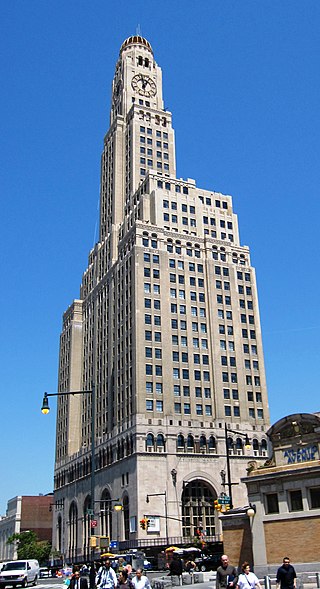
The Williamsburgh Savings Bank Tower, also known as One Hanson Place, is a skyscraper in the Fort Greene neighborhood of Brooklyn in New York City. Located at the northeast corner of Ashland Place and Hanson Place near Downtown Brooklyn, the tower is one of Brooklyn's architectural icons. The tower was designed by Halsey, McCormack and Helmer and constructed from 1927 to 1929 as the new headquarters for the Williamsburgh Savings Bank. From the time of its construction until 2009, One Hanson Place was the tallest building in Brooklyn at 41 stories and 512 feet (156 m) tall.

The Bowery Savings Bank was a bank in New York City, chartered in May 1834. By 1980, it had over 35 branches in the New York metropolitan area. In 1992, it was sold to H. F. Ahmanson & Co. for $200 million.

The PSFS Building, now known as the Loews Philadelphia Hotel, is a skyscraper which is located in Center City, Philadelphia, Pennsylvania. A National Historic Landmark, the building was the first International style skyscraper constructed in the United States.

Dollar Bank is a full-service regional savings bank serving both individuals and business customers, operating more than 90 offices throughout Pennsylvania, Ohio, Maryland, and Virginia. The bank's Pennsylvania headquarters is located in downtown Pittsburgh, Ohio headquarters is located in downtown Cleveland, and Virginia headquarters is located in Hampton Roads.
Apple Bank for Savings is a savings bank headquartered in Manhasset, New York and operating in the New York metropolitan area.
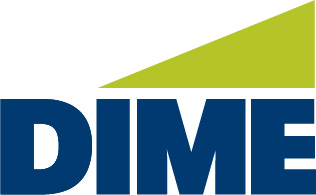
The Dime Community Bank, originally known as the Dime Savings Bank of Williamsburgh, is a local, FDIC-insured bank headquartered in Hauppauge, NY. Founded in 1864, the bank was originally based in the Williamsburg neighborhood of Brooklyn, New York, and continues to operate with a strong market presence in this area. In 2017, Dime moved its headquarters to Brooklyn Heights. On Monday, February 1, 2021, Bridge Bancorp Inc. and Dime Community Bancshares successfully closed on a merger of equals. The bank headquarters is currently in Hauppauge, NY.
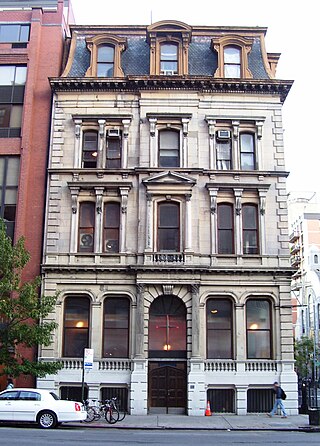
The Metropolitan Savings Bank Building opened on May 30, 1867 at the northeast corner of Third Avenue and East 7th Street, in Manhattan, New York City. Its original address was 10 Cooper Institute. The building, which was designed by architect Carl Pfeiffer in Second Empire style, is four stories high, 45 feet (14 m) wide and 75 feet (23 m) deep, and was considered at the time it opened to be one of the most finely constructed edifices, "from garret to basement." Its facades were composed of white marble, with the upper floor being enclosed by a mansard roof. The building was fireproof, as no combustible materials were used during construction, either internally or externally. The entire cost of the structure was $150,000.

49 Chambers, formerly known as the Emigrant Industrial Savings Bank Building and 51 Chambers Street, is a residential building at 49–51 Chambers Street in the Civic Center neighborhood of Manhattan in New York City. It was built between 1909 and 1912 and was designed by Raymond F. Almirall in the Beaux-Arts style. The building occupies a slightly irregular lot bounded by Chambers Street to the south, Elk Street to the east, and Reade Street to the north.
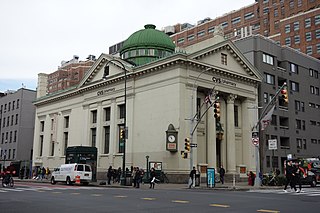
The New York Savings Bank Building is a former bank building in the Chelsea neighborhood of Manhattan in New York City. Constructed for the defunct New York Savings Bank from 1896 to 1898, it occupies an "L"-shaped site on 81 Eighth Avenue, at the northwestern corner with 14th Street. The New York Savings Bank Building was designed by Robert Henderson Robertson, with later additions by George H. Provot and Halsey, McCormack & Helmer. The building's facade and interior are New York City designated landmarks, and the building is listed on the National Register of Historic Places.

The Jamaica Savings Bank was a bank incorporated in 1866 in the Jamaica section of the borough of Queens in New York City. It had four branches across Queens before it was acquired by North Fork Bank in 1999, which itself was acquired by Capital One Bank in 2008.

14th Street is a major crosstown street in the New York City borough of Manhattan, traveling between Eleventh Avenue on Manhattan's West Side and Avenue C on Manhattan's East Side. It forms a boundary between several neighborhoods and is sometimes considered the border between Lower Manhattan and Midtown Manhattan.

The Brooklyn Tower is a supertall mixed-use, primarily residential skyscraper in the Downtown Brooklyn neighborhood of New York City. Developed by JDS Development Group, it is situated on the north side of DeKalb Avenue near Flatbush Avenue. The main portion of the skyscraper is a 93-story, 1,073-foot (327 m) residential structure designed by SHoP Architects. Preserved at the skyscraper's base is the Dime Savings Bank Building, designed by Mowbray and Uffinger, which dates to the 1900s.

110 East 42nd Street, also known as the Bowery Savings Bank Building, is an 18-story office building in Midtown Manhattan, New York City. The structure was designed in the Italian Romanesque Revival style by York and Sawyer, with William Louis Ayres as the partner in charge. It is on the south side of 42nd Street, across from Grand Central Terminal to the north and between the Pershing Square Building to the west and the Chanin Building to the east. 110 East 42nd Street is named for the Bowery Savings Bank, which had erected the building as a new branch structure to supplement its original building at 130 Bowery. The building was erected within "Terminal City", a collection of buildings above the underground tracks surrounding Grand Central, and makes use of real-estate air rights above the tracks. The building is directly above the New York City Subway's Grand Central–42nd Street station.

The Greenwich Savings Bank Building, also known as the Haier Building and 1356 Broadway, is an office building at 1352–1362 Broadway in the Midtown Manhattan neighborhood of New York City. Constructed as the headquarters of the Greenwich Savings Bank from 1922 to 1924, it occupies a trapezoidal parcel bounded by 36th Street to the south, Sixth Avenue to the east, and Broadway to the west. The Greenwich Savings Bank Building was designed in the Classical Revival style by York and Sawyer.

The Williamsburgh Savings Bank Building, also known as the Weylin and 175 Broadway, is a former bank building at 175 Broadway in the Williamsburg neighborhood of Brooklyn in New York City. Constructed as the headquarters of the Williamsburgh Savings Bank in 1875 and subsequently expanded several times, it occupies the northwest corner of Broadway and Driggs Avenue, just south of the Williamsburg Bridge. The Williamsburgh Savings Bank Building was designed in the Classical Revival style by George B. Post, with interiors by Peter B. Wight.

The Bowery Savings Bank Building, also known as 130 Bowery, is an event venue and former bank building in the Little Italy and Chinatown neighborhoods of Lower Manhattan in New York City. Constructed for the defunct Bowery Savings Bank from 1893 to 1895, it occupies an "L"-shaped site bounded by Bowery to the east, Grand Street to the south, and Elizabeth Street to the west. The Bowery Savings Bank Building was designed by Stanford White of McKim, Mead & White. Since 2002, it has hosted an event venue called Capitale. The building's facade and interior are New York City designated landmarks, and the building is listed on the National Register of Historic Places.
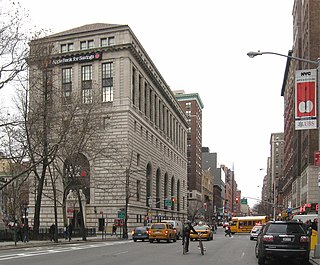
The Apple Bank Building, also known as the Central Savings Bank Building and 2100 Broadway, is a bank and residential building at 2100–2114 Broadway on the Upper West Side of Manhattan in New York City. Constructed as a branch of the Central Savings Bank from 1926 to 1928, it occupies a trapezoidal city block bounded by 73rd Street to the south, Amsterdam Avenue to the east, 74th Street to the north, and Broadway to the west. The Apple Bank Building was designed by York and Sawyer in the Renaissance Revival and palazzo styles, patterned after an Italian Renaissance-style palazzo.
Notes